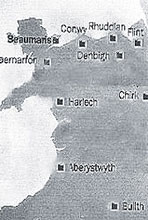Welsh Castle BuildingWelsh Castle Building - The Cost of Welsh Castle Building
- Information and Facts about the Welsh Castle Building program
- The numbers and types of workers involved in Welsh Castle building
- The Architect - Master James of St George
The Welsh Medieval Castle Building task was mammoth! Medieval Concentric Castles were much bigger than the Norman Castles! The Welsh Medieval Castle Building programme introduced thicker, stronger and higher walls interspersed with towers and turrets! The Inner Walls were higher than Outer walls! Drawbridges were added! The Medieval interiors were far more comfortable! The key facts about the Welsh Castle Building of Concentric Castles are as follows: - Welsh Castle Building was Expensive!
- Welsh Castle Building featured heavy defences
- Round or Polygonal shaped Keeps or Towers were introduced
- Walls were built at different heights and levels
- The Various forms of defence such as the Barbican, Portcullis, Gatehouse, Moat, Crenellations, Murder Holes etc were added to the tasks of Welsh Castle Building
Welsh Castle Building was expensive!
The cost of the Welsh Castle Building programme was colossal! Concentric Castles were very expensive! Caernarvon Castle cost King Edward I £27,000 - to build this massive Concentric castle today would cost around £40,000,000! The following extract is taken from a letter regarding the expenses of building Caernarvon Castle, dated February 1296, from Master James of St George and his Clerk of Works, Walter of Winchester, to the King's Exchequer: | "In case you should wonder where so much money could go in a week, we would have you know that we have needed - 400 masons, both cutters and layers, together with 2000 less skilled workmen, 100 carts, 60 wagons and 30 boats bringing stone and sea coal; 200 quarrymen; 30 smiths; and carpenters for putting in the joists and floor boards and other necessary jobs. All this takes no account of the garrison mentioned above, nor of the purchase of material, of which there will have to be a great quantity... The men's pay has been and still is very much in arrears, and we are having the greatest difficulty in keeping them because they simply have nothing to live on." |
The Welsh Castle Building Programme introduced luxury!
The Welsh Castle Building programme required skilled craftsman who were knowledgeable about the building of both military and domestic structures. Welsh Castle Building required higher levels of comfortable castle living! And the appropriate skills were developed to fulfil these needs. Gone were the cold, dark and damp Castles of the Norman era - the Plantagenet rules were looking for Middle Age refinement and luxury! - The Medieval Welsh Building programme saw the use of improved tools such as the chisel, as opposed to axes, which led to more decorative designs and tracery skills
- Plumbing improved and lead was often used for the gutters - At Conwy, Harlech and Caernarfon Castles there is evidence of piped water
- Wainscoting was introduced - wooden panels were used to line the walls of a room
- Welsh Artists were employed - wall paintings covered the walls above the wainscoting
- Welsh Castle interiors were highly colourful - gold paint was a luxurious item which was used in vast quantities!
- Fireplaces were a necessary feature of Welsh Castle Building
- Chimneys were introduced
- Some thatching was still used for roofs but Medieval stone slates, tiling and plastered straw was introduced reducing the risk of fire
- Additional staircases were introduced - many for the private use of the English Lords of the Welsh Castles
- Windows were much bigger, due to the introduction of the pointed arch which could support greater weight, allowing the Welsh Castle walls to be thinner with wider window openings. Panes of glass were added to the windows, often painted with armorial designs, which replaced the horn or wooden shutters
- The interiors of the modern Welsh Castles became lighter and airier
- Kitchens were integrated into the Welsh stone Castles - they included cooking ovens for baking and huge fireplaces for smoking and roasting food. They also had a water supply complete with a sink and drainage
- Cleanliness improved and lavers ( stone basins used for washing ) were provided at the entrances of the dining halls
- Bathing was usually conducted in wooden barrels but simply designed bathrooms were added in Welsh Castles for the English Lords and royalty
- There were many lavatories, called garderobes or privies, included in the building of Welsh Castles. The Privies were positioned as far away from the living chambers as practical and often had double doors added to reduce the smell! Shoots were provided for the discharge which often led to the castle moat. Privy seats were made of wood or stone
- A limited number of Carpets and mats were introduced in the Royal apartments of the new Welsh Castles but floors strewed with straw or rushes were still favoured.
|

